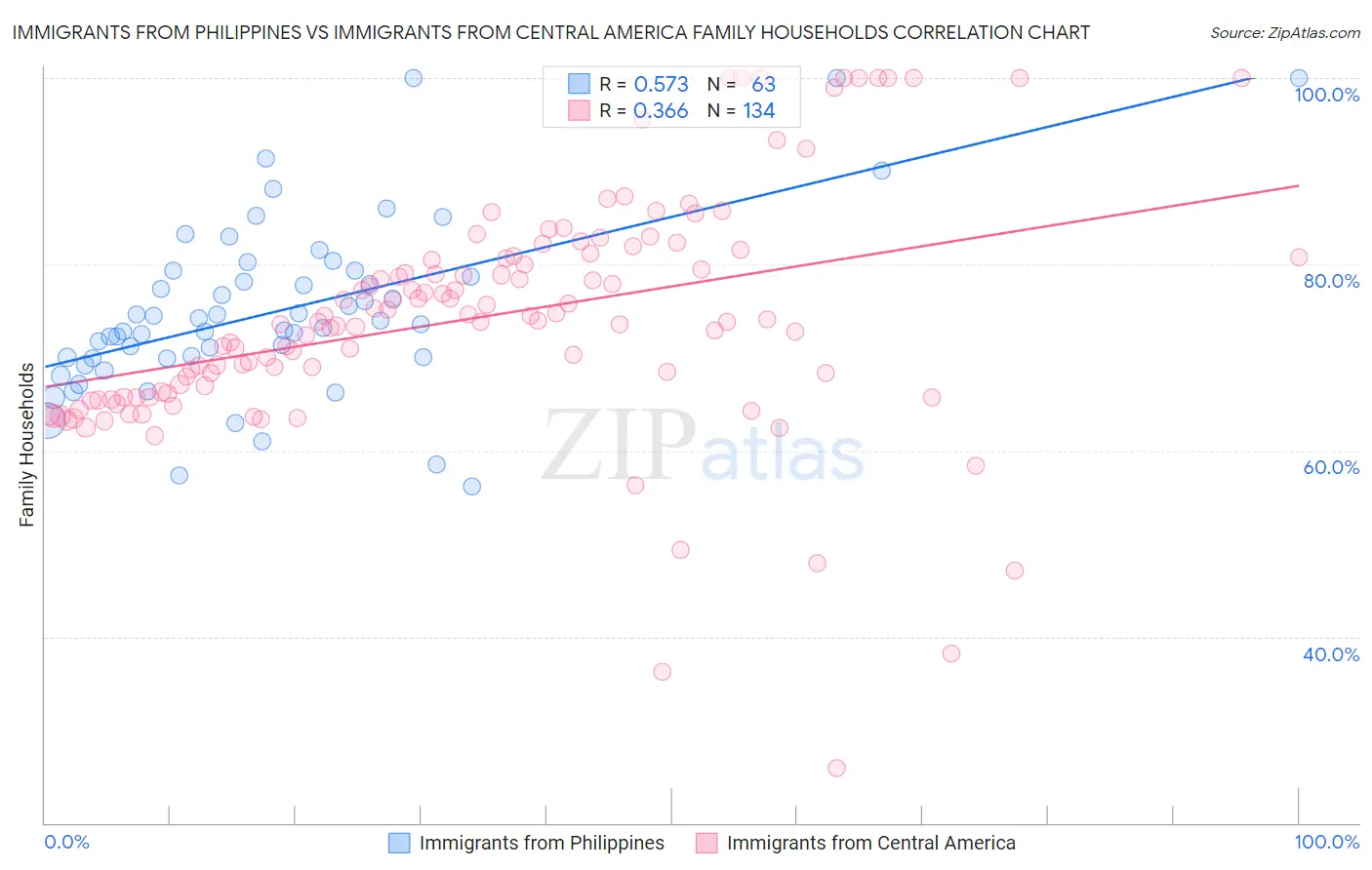Immigrants from Philippines vs Immigrants from Central America Family Households
COMPARE
Immigrants from Philippines
Immigrants from Central America
Family Households
Family Households Comparison
Immigrants from Philippines
Immigrants from Central America
68.3%
FAMILY HOUSEHOLDS
100.0/ 100
METRIC RATING
10th/ 347
METRIC RANK
68.3%
FAMILY HOUSEHOLDS
100.0/ 100
METRIC RATING
11th/ 347
METRIC RANK
Immigrants from Philippines vs Immigrants from Central America Family Households Correlation Chart
The statistical analysis conducted on geographies consisting of 471,023,329 people shows a substantial positive correlation between the proportion of Immigrants from Philippines and percentage of family households in the United States with a correlation coefficient (R) of 0.573 and weighted average of 68.3%. Similarly, the statistical analysis conducted on geographies consisting of 536,086,114 people shows a mild positive correlation between the proportion of Immigrants from Central America and percentage of family households in the United States with a correlation coefficient (R) of 0.366 and weighted average of 68.3%, a difference of 0.070%.

Family Households Correlation Summary
| Measurement | Immigrants from Philippines | Immigrants from Central America |
| Minimum | 56.2% | 25.8% |
| Maximum | 100.0% | 100.0% |
| Range | 43.8% | 74.2% |
| Mean | 74.9% | 74.3% |
| Median | 73.6% | 73.9% |
| Interquartile 25% (IQ1) | 69.9% | 66.1% |
| Interquartile 75% (IQ3) | 79.3% | 80.8% |
| Interquartile Range (IQR) | 9.3% | 14.7% |
| Standard Deviation (Sample) | 9.3% | 12.7% |
| Standard Deviation (Population) | 9.2% | 12.7% |
Demographics Similar to Immigrants from Philippines and Immigrants from Central America by Family Households
In terms of family households, the demographic groups most similar to Immigrants from Philippines are Native Hawaiian (68.4%, a difference of 0.070%), Korean (68.3%, a difference of 0.10%), Pueblo (68.2%, a difference of 0.18%), Immigrants from Cuba (68.2%, a difference of 0.19%), and Assyrian/Chaldean/Syriac (68.2%, a difference of 0.25%). Similarly, the demographic groups most similar to Immigrants from Central America are Korean (68.3%, a difference of 0.030%), Pueblo (68.2%, a difference of 0.11%), Immigrants from Cuba (68.2%, a difference of 0.12%), Native Hawaiian (68.4%, a difference of 0.14%), and Assyrian/Chaldean/Syriac (68.2%, a difference of 0.18%).
| Demographics | Rating | Rank | Family Households |
| Yup'ik | 100 /100 | #1 | Exceptional 72.4% |
| Spanish American Indians | 100.0 /100 | #2 | Exceptional 71.2% |
| Tongans | 100.0 /100 | #3 | Exceptional 69.6% |
| Yakama | 100.0 /100 | #4 | Exceptional 69.3% |
| Yuman | 100.0 /100 | #5 | Exceptional 69.3% |
| Immigrants | Mexico | 100.0 /100 | #6 | Exceptional 69.1% |
| Mexicans | 100.0 /100 | #7 | Exceptional 69.0% |
| Immigrants | Fiji | 100.0 /100 | #8 | Exceptional 68.8% |
| Native Hawaiians | 100.0 /100 | #9 | Exceptional 68.4% |
| Immigrants | Philippines | 100.0 /100 | #10 | Exceptional 68.3% |
| Immigrants | Central America | 100.0 /100 | #11 | Exceptional 68.3% |
| Koreans | 100.0 /100 | #12 | Exceptional 68.3% |
| Pueblo | 100.0 /100 | #13 | Exceptional 68.2% |
| Immigrants | Cuba | 100.0 /100 | #14 | Exceptional 68.2% |
| Assyrians/Chaldeans/Syriacs | 100.0 /100 | #15 | Exceptional 68.2% |
| Immigrants | Vietnam | 100.0 /100 | #16 | Exceptional 68.2% |
| Chinese | 100.0 /100 | #17 | Exceptional 68.1% |
| Immigrants | Taiwan | 100.0 /100 | #18 | Exceptional 68.0% |
| Samoans | 100.0 /100 | #19 | Exceptional 67.9% |
| Inupiat | 100.0 /100 | #20 | Exceptional 67.8% |